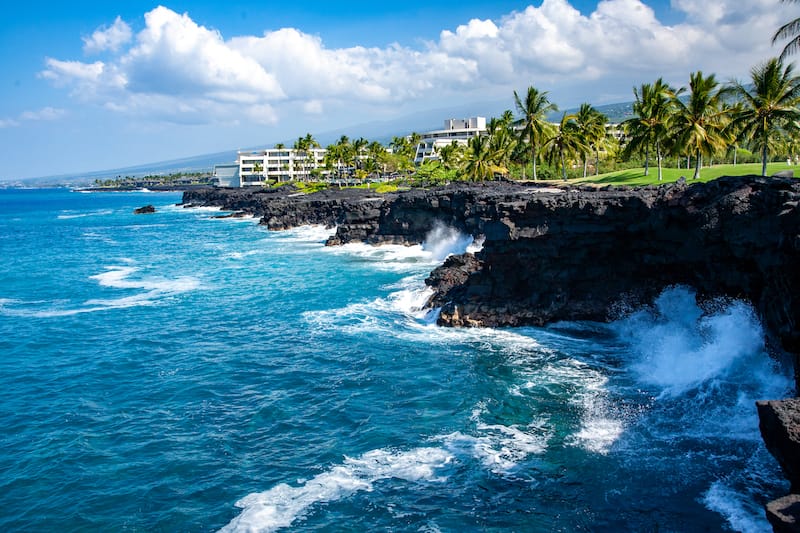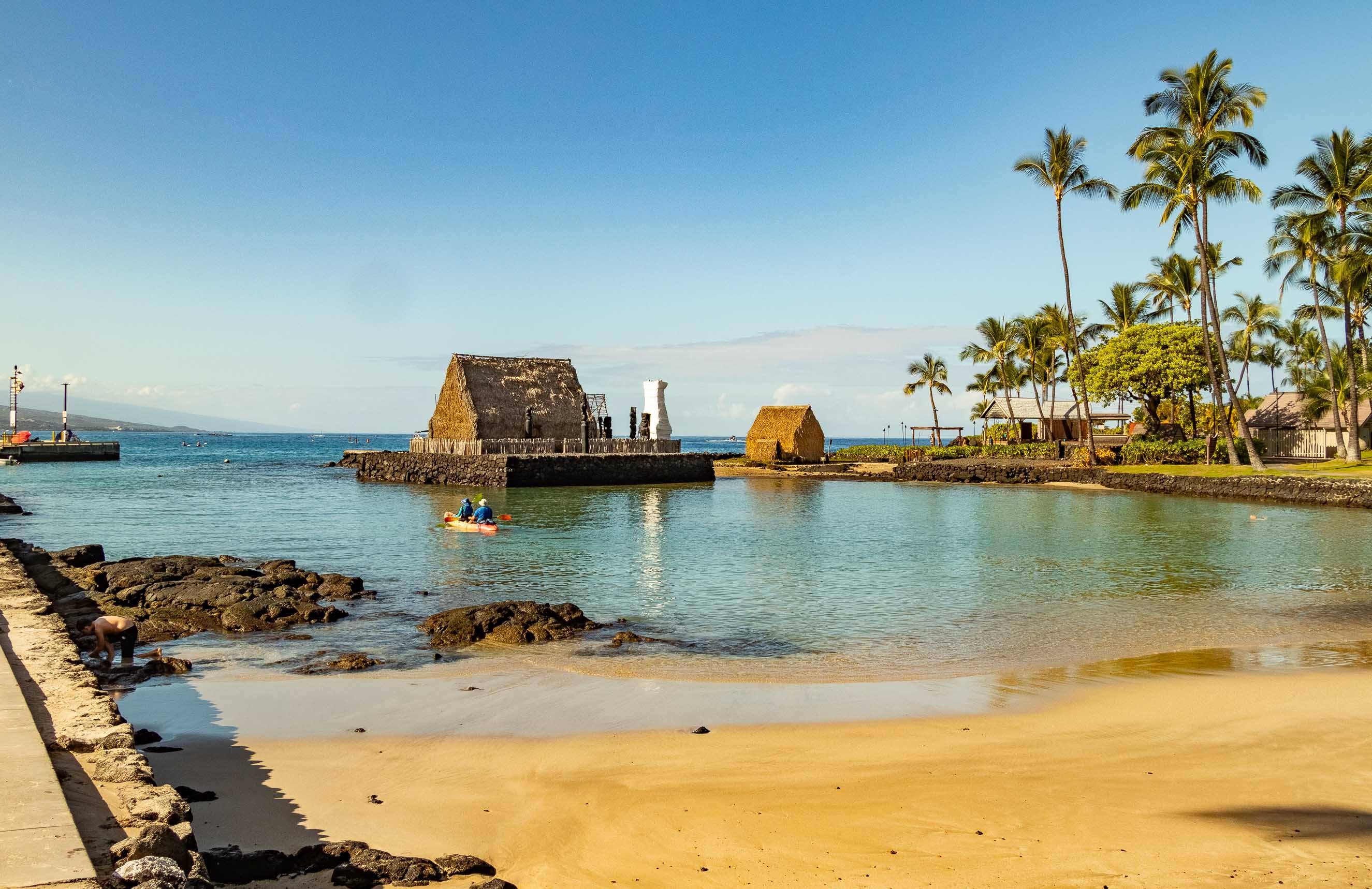Kona Island Geography and Environment

Kona Island, a captivating gem nestled in the heart of the Pacific Ocean, is a testament to the raw power and beauty of nature. Its unique landscape, a product of volcanic activity over millions of years, is a sanctuary for diverse ecosystems and a haven for a wealth of flora and fauna. However, like many other island paradises, Kona faces the looming shadow of climate change, posing a significant threat to its delicate balance.
Volcanic Origins and Formation, Kona island
Kona Island is a volcanic marvel, born from the fiery depths of the Earth. Its formation is a captivating story of geological forces at work. The island is part of the Hawaiian-Emperor seamount chain, a string of volcanic mountains that stretches for thousands of kilometers across the Pacific Ocean. The chain was formed by the movement of the Pacific Plate over a stationary “hot spot” in the Earth’s mantle. This hot spot, a plume of molten rock, has been spewing lava for millions of years, creating a chain of volcanic islands as the plate moves over it.
Kona Island is composed of five shield volcanoes: Kohala, Mauna Kea, Hualalai, Mauna Loa, and Kilauea. These volcanoes, formed by the slow, effusive eruptions of basaltic lava, have shaped the island’s distinctive landscape. The island’s western side, where Kona is located, is characterized by gentle slopes and rolling hills, formed by the eruptions of Hualalai and Mauna Loa.
Diverse Ecosystems
Kona Island is a vibrant tapestry of ecosystems, each with its own unique flora and fauna. The island’s diverse topography, ranging from arid coastal plains to lush rainforests, supports a wide variety of habitats.
The island’s coastal regions are home to a diverse array of marine life. The clear, warm waters teem with colorful coral reefs, home to a dazzling array of fish, invertebrates, and marine mammals. The rocky shores are a haven for seabirds, while the sandy beaches are a nesting ground for sea turtles.
The island’s interior is characterized by lush forests, home to a variety of native plants and animals. The rainforests are dominated by koa trees, a prized hardwood known for its strength and beauty. These forests are also home to a variety of endemic birds, including the Hawaiian honeycreeper, a group of birds that have evolved to specialize in feeding on the nectar of native flowers.
Impact of Climate Change
Climate change is a growing concern for Kona Island, as it poses a significant threat to its environment and the livelihoods of its inhabitants. Rising sea levels threaten to inundate coastal areas, eroding beaches and displacing coastal communities. Increased ocean acidity, caused by the absorption of carbon dioxide from the atmosphere, is damaging coral reefs, impacting the marine ecosystem and the livelihoods of fishermen.
Changes in rainfall patterns are also affecting the island’s ecosystems. Droughts are becoming more frequent and severe, stressing water resources and threatening the island’s forests. Extreme weather events, such as hurricanes and floods, are becoming more intense, damaging infrastructure and disrupting daily life.
Kona Island Culture and History

Kona Island is steeped in a rich cultural heritage, shaped by the traditions and practices of its indigenous Hawaiian people. The island’s history is interwoven with the fabric of Hawaiian history, playing a pivotal role in significant events that have shaped the nation. The stories and legends passed down through generations reflect the island’s cultural richness and offer a glimpse into its fascinating past.
Indigenous Hawaiian Traditions
The indigenous Hawaiian people have long held a deep connection to the land and sea, their culture deeply intertwined with the natural world. They have a rich tradition of oral history, passed down through generations through chants, songs, and stories. This tradition provides valuable insights into their beliefs, values, and way of life.
Traditional Practices
- Hula: Hula is a sacred form of dance that tells stories and expresses emotions. It is an integral part of Hawaiian culture, performed at ceremonies, celebrations, and gatherings.
- Lei Making: Lei, garlands of flowers, leaves, or other materials, are a symbol of love, respect, and affection. They are worn on special occasions and are an integral part of Hawaiian culture.
- Fishing: Fishing has been a vital part of Hawaiian life for centuries. Traditional fishing methods, such as using nets, spears, and hooks, are still practiced today.
- Agriculture: Agriculture has been central to Hawaiian society for centuries. The island’s volcanic soil is fertile, supporting the growth of various crops, including taro, sweet potatoes, and bananas.
Historical Significance
Kona Island has played a significant role in Hawaiian history, with its location and resources making it a strategic center for trade, agriculture, and cultural development.
Role in Hawaiian History
- Keauhou: The historic port of Keauhou was a major center of trade and commerce in ancient Hawaii. It served as a hub for the exchange of goods, knowledge, and cultural practices between different islands.
- Keaweikekahialiʻi: Keaweikekahialiʻi, a renowned aliʻi (chief) of the Big Island, was instrumental in unifying the island under his rule. His legacy is deeply intertwined with the history of Kona.
- Captain Cook’s Arrival: The arrival of Captain James Cook in 1778 marked a significant turning point in Hawaiian history. Kona Island played a pivotal role in this event, as Cook’s ship, the Resolution, landed at Kealakekua Bay.
Legends and Folklore
Kona Island is rich in legends and folklore, passed down through generations, offering a glimpse into the island’s cultural heritage and beliefs. These stories often feature mythical creatures, gods, and heroes, reflecting the island’s unique history and traditions.
Notable Legends
- Pele, the Goddess of Volcanoes: Pele is a prominent figure in Hawaiian mythology, known as the goddess of volcanoes, fire, and lava. Her story is deeply intertwined with the island’s volcanic landscape.
- Maui, the Trickster God: Maui is another prominent figure in Hawaiian mythology, known for his cleverness and strength. He is credited with feats such as fishing up the islands and capturing the sun.
- The Legend of the Menehune: The Menehune are a mythical race of people in Hawaiian folklore, known for their incredible skill in construction and their ability to complete tasks overnight.
Kona Island Tourism and Activities

Kona Island is a renowned destination for its stunning natural beauty, rich culture, and diverse range of activities. From world-class snorkeling and diving to captivating historical sites and vibrant local markets, there is something to suit every traveler’s interests.
Popular Tourist Attractions
Kona Island boasts a variety of popular tourist attractions, each offering unique experiences and insights into the island’s natural and cultural heritage.
- Kealakekua Bay: This historic bay is a significant landmark, known for being the site of Captain Cook’s first landing in Hawaii in 1778. Today, visitors can explore the bay by boat, kayak, or stand-up paddleboard, enjoying breathtaking views and encountering marine life.
- Hawaii Volcanoes National Park: While not directly on Kona Island, this park is a short drive away and offers an awe-inspiring experience. Witness active volcanoes, lava flows, and unique volcanic landscapes. Explore the park’s trails, observe volcanic activity, and learn about the geological history of the island.
- Pu’uhonua o Honaunau National Historical Park: This ancient Hawaiian place of refuge provides a glimpse into the island’s rich cultural past. Explore the park’s archaeological sites, including the heiau (temple), fishponds, and petroglyphs. Learn about the traditions and beliefs of the ancient Hawaiians and the significance of this sacred site.
- Keauhou Shopping Center: This open-air shopping center offers a wide variety of shops, restaurants, and cultural experiences. Browse local crafts, souvenirs, and art, enjoy delicious Hawaiian cuisine, and witness traditional Hawaiian music and dance performances.
- Manta Ray Night Dive/Snorkel: Experience the magic of manta rays up close on a nighttime snorkeling or diving excursion. Witness these graceful creatures gliding through the water as they feed on plankton illuminated by underwater lights.
Activities and Experiences
Kona Island offers a wide range of activities and experiences for visitors to enjoy, catering to diverse interests and preferences.
- Snorkeling and Diving: Explore the vibrant coral reefs and diverse marine life of Kona’s waters. Numerous snorkeling and diving sites offer encounters with colorful fish, turtles, and even manta rays.
- Hiking: Discover the island’s diverse landscapes on hiking trails ranging from easy strolls to challenging climbs. Explore lush rainforests, volcanic craters, and coastal paths offering panoramic ocean views.
- Cultural Tours: Immerse yourself in the rich culture and history of Kona Island. Join guided tours to learn about ancient Hawaiian traditions, visit historical sites, and experience traditional music and dance performances.
- Coffee Plantation Tours: Kona is renowned for its high-quality coffee. Visit local coffee plantations to learn about the growing process, sample different blends, and purchase freshly roasted beans.
- Sunset Cruises: Enjoy breathtaking sunset views over the Pacific Ocean on a romantic cruise. Many cruises offer live music, cocktails, and delicious snacks.
Visiting Kona Island: A Comprehensive Guide
Planning a trip to Kona Island? Here’s a comprehensive guide to help you make the most of your visit.
Accommodation
Kona Island offers a wide range of accommodation options, from luxurious resorts to cozy bed and breakfasts. Consider your budget and preferences when choosing a place to stay.
- Resorts: For a luxurious experience, choose a resort with amenities like pools, spas, and fine dining.
- Hotels: For a more budget-friendly option, consider staying in a hotel. Many hotels offer convenient locations and basic amenities.
- Vacation Rentals: For a more private and homey experience, consider renting a condo or villa.
- Bed and Breakfasts: For a personalized and intimate stay, choose a bed and breakfast. Many offer charming accommodations and delicious breakfasts.
Dining
Kona Island offers a diverse culinary scene, featuring fresh seafood, local produce, and international flavors.
- Seafood Restaurants: Enjoy fresh catches of the day at numerous seafood restaurants along the coast.
- Hawaiian Cuisine: Experience traditional Hawaiian cuisine at local restaurants offering dishes like kalua pig, poi, and laulau.
- International Cuisine: Kona Island offers a variety of international cuisines, including Italian, Japanese, and Mexican.
- Food Trucks: Explore the local food truck scene for a casual and affordable dining experience.
Transportation
Getting around Kona Island is easy with various transportation options.
- Rental Car: A rental car provides the most flexibility for exploring the island at your own pace.
- Public Transportation: Kona Island has a public bus system that connects major destinations.
- Taxi: Taxis are available for short trips within the Kona area.
- Tour Operators: Consider booking tours with local operators for guided excursions and transportation.
Kona Island, with its stunning beaches and rich volcanic landscape, is a popular destination for travelers. If you’re planning a trip to this Hawaiian paradise, consider taking advantage of Alaska Airlines’ buy one get one deals to save on your flights.
With affordable airfare, you can spend more time exploring the wonders of Kona Island, from its world-renowned coffee plantations to its pristine snorkeling spots.
Kona Island, with its stunning beaches and vibrant culture, is a popular destination for travelers from all over the world. Whether you’re planning a romantic getaway or a family vacation, you’ll want to make sure you’re comfortable on your flight.
To help you choose the perfect seat for your needs, be sure to check out the Alaska Airlines seating chart before you book. Once you arrive in Kona, you’ll be ready to explore all that this beautiful island has to offer.
